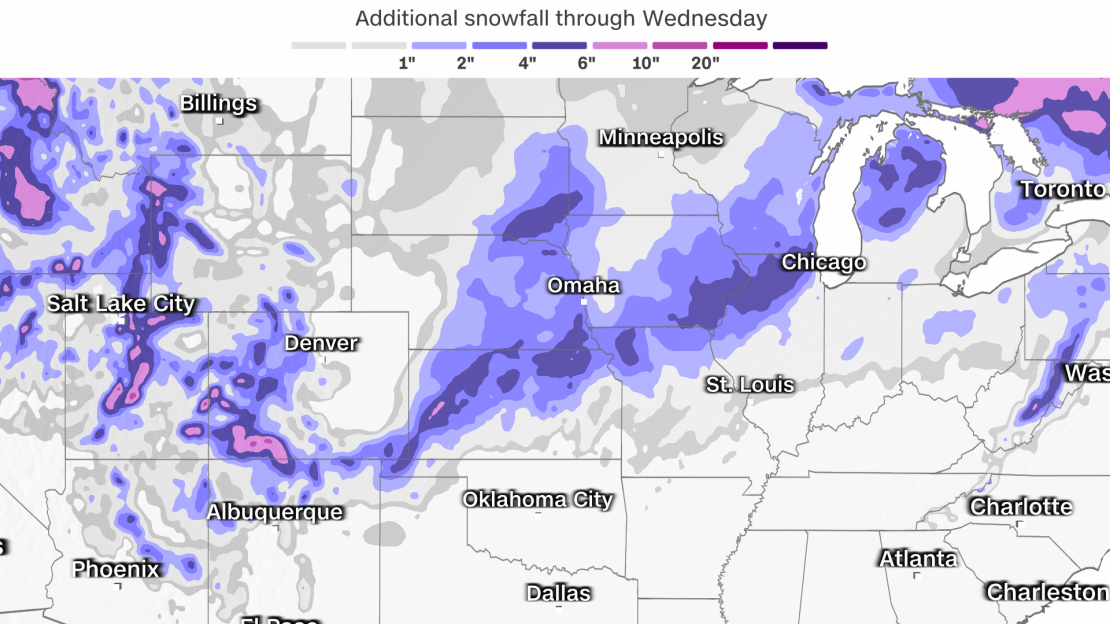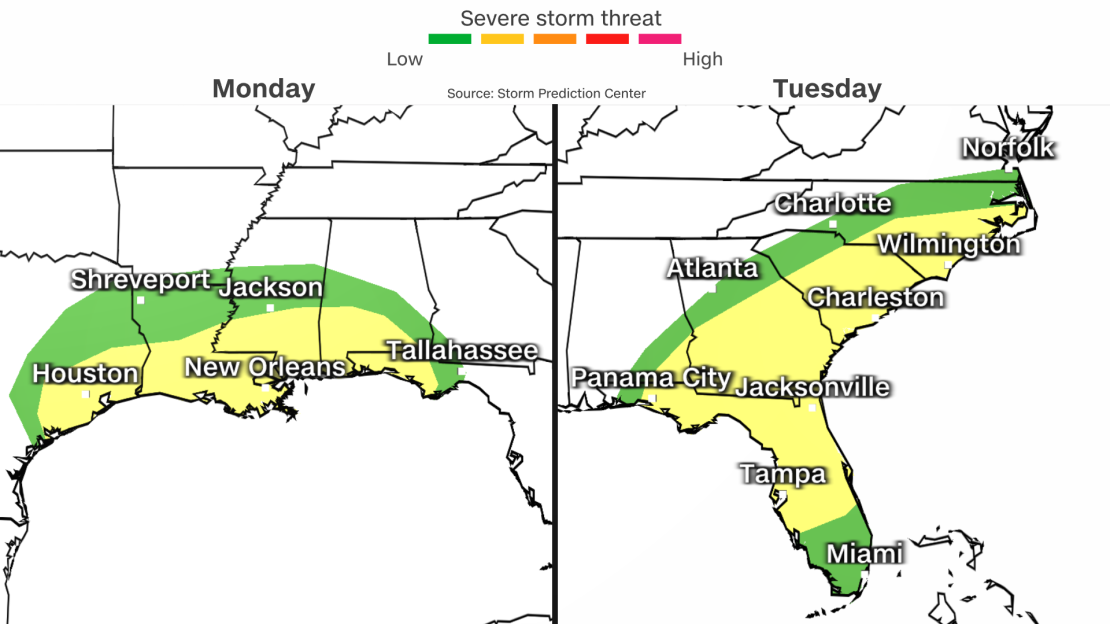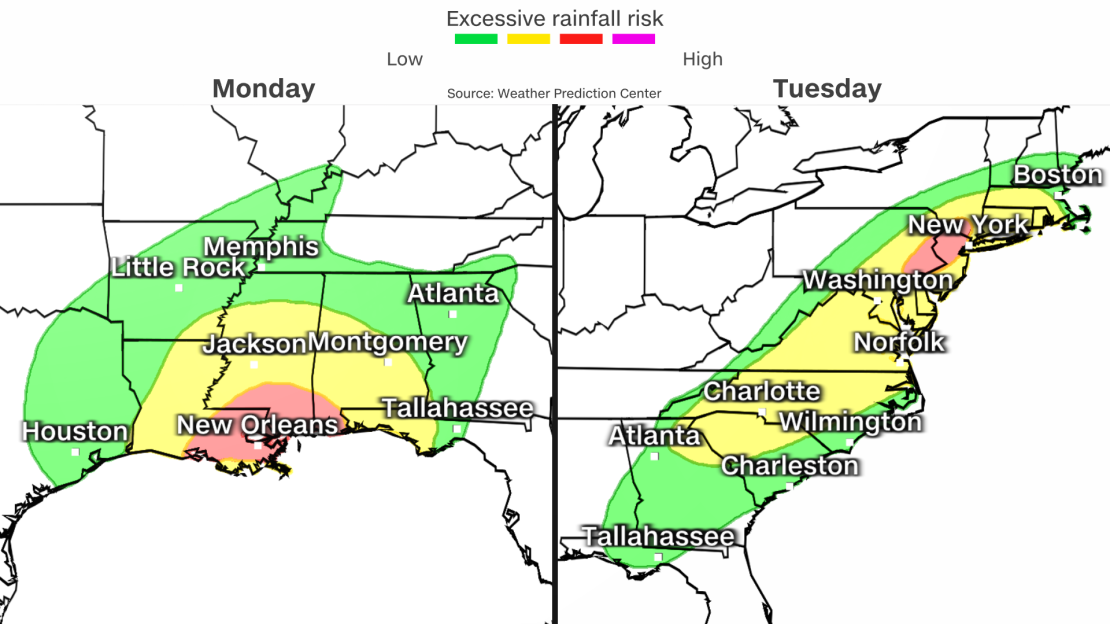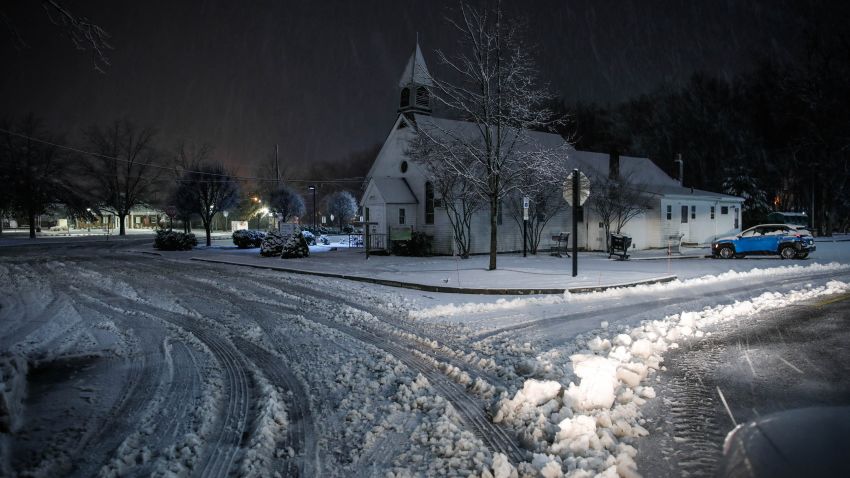Nearly 70 million people across the Gulf Coast and Southeast are at risk for severe weather, including tornadoes, damaging wind and flooding rain on Monday and Tuesday, according to the Storm Prediction Center.
Days after the season’s first big winter storm, another storm is on the move and is expected to bring heavy snow, blizzard conditions, strong winds, potential tornadoes and serious flooding as it carves a path from the Southwest to the Northeast through midweek.
There is now a Level 3 of 5 enhanced risk Monday for cities like New Orleans, Louisiana, Gulfport, Mississippi and Mobile, Alabama, as storms sweep across the area in the afternoon and overnight. Tornadoes are especially likely in this area. Additionally, there is also a Level 3 of 4 moderate risk of excessive rainfall with 3 to 5 inches expected, which could lead to flooding.
On Tuesday, the same system moves further east, where there is an enhanced risk of severe weather for cities like Tallahassee, Florida, Albany, Georgia, and Panama City, Florida in the early morning and continuing into the afternoon.
The coming disruptive weather arrives just a day after a winter storm dumped more than a foot of snow on the Northeast and brought rain, snow, ice and even a tornado as it tracked from the Gulf Coast to Maine.
The latest system is expected to rapidly strengthen into an exceptionally powerful January storm and cause widespread, significant effects east of the Rockies beginning Monday.
Although it will be a fast-moving system, traversing over 1,800 miles in 72 hours, it will still produce notable snowfall across more than a half a dozen states.
Widespread snowfall accumulations of at least 6 inches are expected from northern New Mexico to the Upper Peninsula of Michigan.
Heavy snow and strong winds will create blizzard conditions Sunday as the storm exits Arizona and heads to the Texas and Oklahoma panhandle region Sunday night. Blizzard warnings were already hoisted in Colorado and New Mexico early Sunday morning.

Poor visibility and difficult-to-near-impossible driving conditions will set in for the Southwest on Sunday, the central and southern Plains on Monday and the Midwest on Tuesday.
Strong winds will also bring wind chill values below zero degrees for some locations in the Plains.
Snow and cold temperatures will not be the only concerns as the storm surges northeast, intensifies and expands its reach to much of the eastern half of the US into the middle of the week.
Flooding, damaging winds and even tornadoes will also be concerns.
Along the Gulf Coast, warm, moist air will fuel the threat for severe storms, including a few strong tornadoes and damaging winds.

More than 15 million people are under a severe storm threat Monday from Texas to Florida. Over 35 million people are under the same threat level Tuesday from the Panhandle of Florida to the Outer Banks of North Carolina.
An equally serious concern is the potential for significant flooding from the storm’s strong winds blowing water onshore and its potent rainmaking storms.
“Widespread and potentially significant river and flash flooding are likely from the central Gulf Coast through much of the Eastern U.S. early this week,” the Weather Prediction Center said. “Powerful onshore winds will lead to widespread coastal flooding along the eastern Gulf Coast and much of the East Coast.”
Widespread rainfall totals of 1 to 3 inches are expected from the Gulf Coast to New England with isolated locations exceeding 4 inches.
There’s serious concern for flooding in the Northeast with this next wave of rain coming right after the first snowstorm dropped more than half a foot of snow in multiple Northeast states.
Heavy rain will accelerate snowmelt and increase the amount of water running off into waterways, raising the ceiling on the flood potential in these areas. As a result, there is a Level 3 out of 4 risk for flooding in portions of New Jersey, New York and Pennsylvania on Tuesday. A Level 2 of 4 threat spans nearly the entire path of the first storm – from Georgia through Massachusetts.

A Level 3 of 4 risk for flooding is also in place along the western coast of Louisiana to the Florida Panhandle for the flood potential from the initial round of rain on Monday.
The rainfall is both a gift and a concern for Louisiana and Mississippi – both still grappling with serious droughts, though drought has already improved substantially since November from a recent overabundance of rain.
Locations along the Gulf Coast from New Orleans to Tallahassee, Florida, are more than 5 inches above normal for rainfall since December 1, so it won’t take much for the saturated ground to flood.
Wind is another concern with saturated ground. It makes trees more vulnerable to toppling over onto power lines or homes. And the winds will be strong enough to cause such damage.
“Gusty winds on the warm side of the storm may exceed 50 MPH and cause damage over the Appalachians to the East Coast,” the Weather Prediction Center said. The center also warned people to “prepare for power outages” from the potentially damaging winds.
The strongest winds will be closer to the coast.
High wind watches will likely be issued in the next 24 hours, but the National Weather Service office in Boston noted they might need to issue hurricane-force wind watches – warning of winds akin to a Category 1 hurricane – for coastal areas if the storm’s worst forecast fears came to pass.
Winds will also trigger high surf of 8 to 11 feet and significant beach erosion is possible. Dangerous rip currents are also likely and will continue through at least the middle of the week.
The storm system looks to wrap up near the end of the week, but another storm looks like it could follow a similar path and affect some of the same areas later in the week and into the weekend.
CNN meteorologist Gene Norman contributed to this report.




















